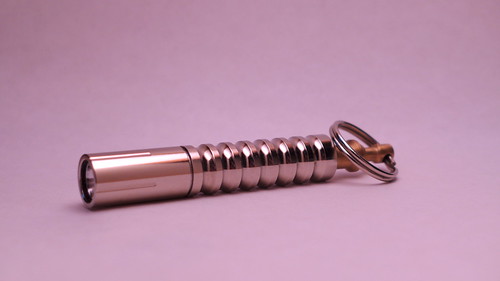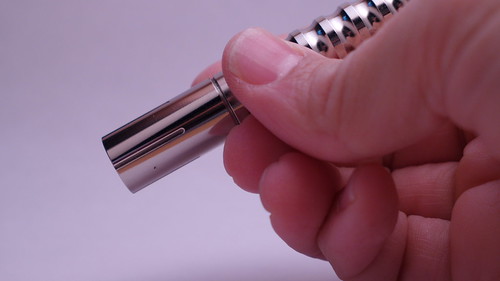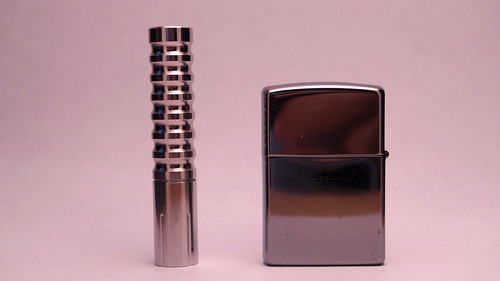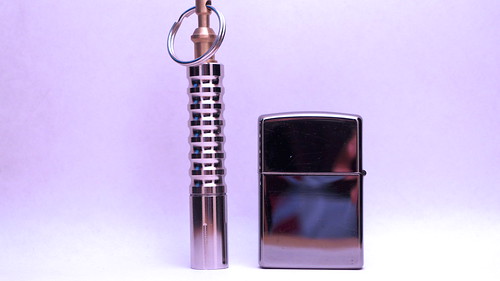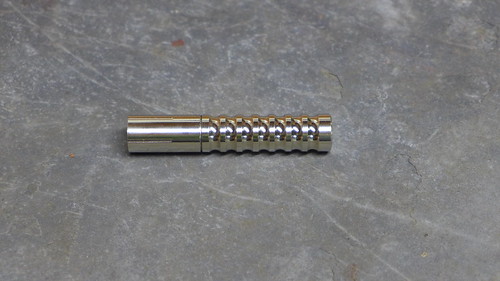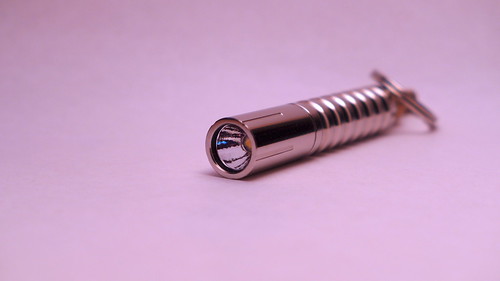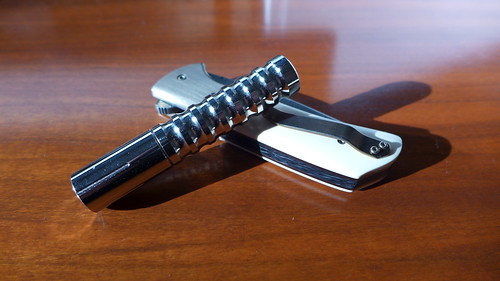Prometheus Beta-QR Review
At some point we have to acknowledge that the tacticool look has run its course. There are a small group of people, mainly us, that appreciate function over form and can tolerate the technical look of gear. We appreciate things like matte surface coatings and pocket clips. But we are a small part of the market. For a product to truly break out, it needs to appeal to folks besides us. Look at the Mag Solitaire, perhaps the most ubiquitous keychain light in the world. It is a terrible light, really, with a miserable run time and output, even with the new LED update, but it looks like something familiar, like a pen or a tube of lipstick. Its appearance appeals to a broad audience, even if its performance is matchstick bad.
The Prometheus Beta-QR just might be the light to cross over into the mainstream. It has the looks and the performance to appeal to the masses and to us. And it has an ingenious feature, the quick release tail, that makes is very useful and very different from the vast majority of lights out there. Additionally, Prometheus a.k.a. Jason Hui has focused on features that make a difference in real life. He has delivered a light that is unlike the horde of feature laden, tacticool stuff. The Prometheus Beta-QR is neither feature laden nor ugly. This is a light designed by focusing on use, as opposed to a bullet list of features. It is also an undulating piece of metal sculpture.
By now you are probably used to reading about great lights here and wondering about how you could get one before you scroll around on the internet and find out they are three figure gems, quite a bit for a flashlight. The Beta-QR is a light that can be had for much less than $100. This is an inexpensive light, especially for the performance. There is a catch though (everything has a catch, TINSTAAFL)--this isn't a custom light like we are used to from Jason Hui. This is a production light designed and spec'ed by Hui and produced in China. If the prototype that I had for review is any indication, the quality is superb. If China's a deal breaker for you, well, your missing out. This is one hell of a cool light.
Here is the product page (some of the specs have changed, see the KS page for final specs and features). The Beta-QR costs between $35 and $60 on Kickstarter and the production version will run about $60. There are four models: the electroplated version, the black Hard Anodized version (HA III), the limited edition Green Anodized version (HA II and serialized 1-100), and a three mode copper version. The green version is sold out. The early bird for $35 is also sold out. Right now you can get one for $45 (choosing between a HAIII version or an electroplated version) or the copper three speed for $65. You can also get both the black and electroplated models for $80 or all three (electroplated, black, and copper) for $145. Though I am sure the black hard anodized is nice and will hold up best to keychain use, it is virtually criminal to ignore the Jason's electroplated goodness. This is the first and to my knowledge only review of the Prometheus Beta-QR. Here is my review sample:
Twitter Review Summary: The Beta-QR brings high performance and great convenience to the masses in the best keychain light available.
Design: 2
This is a light that looks at home among the iPhones and high tech key fobs of the world. It looks classy and feels solid. All but the black version eschew the tactical look in favor of something that your more likely to see in a MoMA catalog than an Army Navy surplus store. But this design is more than a pretty shell. It really, really works. Jason picked the best stuff. He focused on the light quality which so many people ignore, especially in the 1xAAA format. Instead of falling in line with the lumens arms race he gives us wonderful Hi CRI output. But that is not all, Jason solved one of the biggest design problems in small flashlights--how to attach it to your keychain without screwing up other parts of the light. The QR is really great. The light tailstands like a champ and quickly and easily detaches from your keys unlike all of the split ring lights out there. These features and the appearance give the Beta-QR mainstream appeal that most of our gear lacks and the price is not too crazy either. Lots of folks will probably still balk at the $50-$60 price point, but in a world of $5 coffees (20 times more than a cup o joe when the Solitaire was released) the price is commensurate with the looks and performance.
This is a small light, as all 1xAAA lights are, but it is not super tiny. Here it is in my hand:
and here it is next to the equally lustrous Zippo:
and here it is with the QR:
The performance numbers aren't too bad. With batteries it weighs in at 1.2 ounces, making the lumens:weight on the highest output mode (found on the Copper Three Speed) a very decent 70.83. The total lumens output is 4500 (found on the Two Speed high of 60 lumens for 75 minutes). For comparison's sake the MBI HF-R is 3600 and the Surefire EB1 is 260.
Fit and Finish: 2
Worry if you want about the country of origin, but I can assure you it is a waste. This is a great light. It has much thicker walls than you'd think it would given its size and most other Chinese made lights. It is also expertly cut, as the threads synch together nicely. The QR is a little wobbly, but that is the nature of the beast; it is nothing irksome and it is plenty strong. The emitter was nicely centered and the electroplating is sumptuous. I loved it. My one concern, and one I couldn't assess during a review period, is the electroplating's ability to withstand the rough and tumble world of the keychain. Few things can administer abuse like a keychain, but in the testing period it did fine riding on my keychain, getting cozy with my pocket knife, and riding shotgun with a few metal barreled pens.
Grip: 2
The undulating waves of gleaming metal aren't just pretty, they are actually quite grippy. I don't mean that they will work with thick tactical or work gloves, but in normal EDC use they are more than enough.
As you can see from the shadows in the picture above the grooves are actually quite deep. This not only makes the barrel thicker, it also helps the pads of your fingers lock into place.
Carry: 2
All 1xAAA carry very well and the Beta-QR is no different. This is the reason why the format has taken off in the past 12-18 months. Here is a piece I did on AllOutdoor regarding this trend. The real trick with the Beta-QR comes here. The QR retention method is revolutionary in the flashlight world. Looking back at my lights over time you can see all of the contorted designs that all tried to do the same thing--allow the light to both tailstand AND attach to a split ring for easy carry. None work as well as the QR and it is not even close. I'd give the light a 3 if I could here.
Output: 2
If you limit yourself to alkaline and NiMH only the most you can realistically get out of the current generation of emitters is about 85 lumens. And to get that output here PLUS have a 92 CRI, well I am not sure how it gets better in this format with those batteries.
The Peak Eiger can kill this light with a Li-Ion rechargeable, but it is no one's idea of a mainstream friendly light, both because of the finnicky QTC and the danger of lithium rechargeables. Given the format and the batteries is light represents the state of the art.
Runtime: 2
99% of the time you need something like 30-40 lumens. Getting twice that for 75 minutes, as you can see from the total lumens output numbers, is quick good for a light this size. Again, there are uber expensive lights, like my beloved Aeon Mk. II, that do much better, but that light is almost 10 times the price of this one. Similarly priced lights or other lights in the format are little worse than the Beta-QR.
Beam Type: 2
I have a prototype and Jason was playing around with outputs on this light, so it would be misleading for me to do beam shots. None of the lights for sale will have the output or mode configuration the review sample does, but the reflector is set and it is quite impressive. There is a surprising amount of throw here. Nothing crazy, nothing spill killing like the Surefire lights, but I imagine it would let you hit a car ten spots over in a dark parking lot with ease. I am impressed by the balance between the spill and hot spot here, especially given the light's size.
Beam Quality: 2
I am a Tint Snob. You know that. The funny thing is, EVERYONE is a tint snob, even if they don't know it. Its why there is Hi CRI lighting in changing rooms, art galleries, and in jewelry cases. Our eyes thrive on light that emulates sun light and the Nichia 219 emitter is the best emitter available in this regard. There are, of course, no artifacts, rings or spots. This is a clean beam of almost sun like quality.
UI: 1
Here is the only place where the Beta-QR is not quite cutting edge. The twist, twist again UI is not my favorite. It is definitely workable, as the hundreds of thousands of Mini 47s lights can attest to, but it is not the best. I like the QTC UI, the selector ring UI, the staged twisty, and the MBI "clock face" UI better. There are limits to what you can do on a light that sells for $60 or less and this seems to be the place where the price impacts the light. Faced with the dilemmas of production, I'd probably have made the same choice Jason did.
Hands Free: 2
Tailstanding is superb and the QR prevents the light from rolling away. It is also a slender enough light to hold between your teeth or lips in a pinch. Again the genius of the QR really makes this light.
Overall Score: 19 out of 20.
The Mag Solitaire works so well because it looks familiar and is always close at hand. But its performance is dreadful. Here we have a light that will also be close at hand and look nothing like a tacticool light, but really kills it on the performance front. If you haven't backed the Beta-QR already, you should. Jason accomplished his goal. This is the best keychain light available. Forced to choose between this, the MBI, and the Eiger, I'd starve like Buridan's Ass. The MBI is probably better, but it is twice as much. Prometheus does it again, and this time he is bringing fire to the masses.
Here's the Beta-QR with my Gedraitis Pathfinder...what a beautiful pair.
The Prometheus Beta-QR just might be the light to cross over into the mainstream. It has the looks and the performance to appeal to the masses and to us. And it has an ingenious feature, the quick release tail, that makes is very useful and very different from the vast majority of lights out there. Additionally, Prometheus a.k.a. Jason Hui has focused on features that make a difference in real life. He has delivered a light that is unlike the horde of feature laden, tacticool stuff. The Prometheus Beta-QR is neither feature laden nor ugly. This is a light designed by focusing on use, as opposed to a bullet list of features. It is also an undulating piece of metal sculpture.
By now you are probably used to reading about great lights here and wondering about how you could get one before you scroll around on the internet and find out they are three figure gems, quite a bit for a flashlight. The Beta-QR is a light that can be had for much less than $100. This is an inexpensive light, especially for the performance. There is a catch though (everything has a catch, TINSTAAFL)--this isn't a custom light like we are used to from Jason Hui. This is a production light designed and spec'ed by Hui and produced in China. If the prototype that I had for review is any indication, the quality is superb. If China's a deal breaker for you, well, your missing out. This is one hell of a cool light.
Here is the product page (some of the specs have changed, see the KS page for final specs and features). The Beta-QR costs between $35 and $60 on Kickstarter and the production version will run about $60. There are four models: the electroplated version, the black Hard Anodized version (HA III), the limited edition Green Anodized version (HA II and serialized 1-100), and a three mode copper version. The green version is sold out. The early bird for $35 is also sold out. Right now you can get one for $45 (choosing between a HAIII version or an electroplated version) or the copper three speed for $65. You can also get both the black and electroplated models for $80 or all three (electroplated, black, and copper) for $145. Though I am sure the black hard anodized is nice and will hold up best to keychain use, it is virtually criminal to ignore the Jason's electroplated goodness. This is the first and to my knowledge only review of the Prometheus Beta-QR. Here is my review sample:
Twitter Review Summary: The Beta-QR brings high performance and great convenience to the masses in the best keychain light available.
Design: 2
This is a light that looks at home among the iPhones and high tech key fobs of the world. It looks classy and feels solid. All but the black version eschew the tactical look in favor of something that your more likely to see in a MoMA catalog than an Army Navy surplus store. But this design is more than a pretty shell. It really, really works. Jason picked the best stuff. He focused on the light quality which so many people ignore, especially in the 1xAAA format. Instead of falling in line with the lumens arms race he gives us wonderful Hi CRI output. But that is not all, Jason solved one of the biggest design problems in small flashlights--how to attach it to your keychain without screwing up other parts of the light. The QR is really great. The light tailstands like a champ and quickly and easily detaches from your keys unlike all of the split ring lights out there. These features and the appearance give the Beta-QR mainstream appeal that most of our gear lacks and the price is not too crazy either. Lots of folks will probably still balk at the $50-$60 price point, but in a world of $5 coffees (20 times more than a cup o joe when the Solitaire was released) the price is commensurate with the looks and performance.
This is a small light, as all 1xAAA lights are, but it is not super tiny. Here it is in my hand:
and here it is next to the equally lustrous Zippo:
and here it is with the QR:
The performance numbers aren't too bad. With batteries it weighs in at 1.2 ounces, making the lumens:weight on the highest output mode (found on the Copper Three Speed) a very decent 70.83. The total lumens output is 4500 (found on the Two Speed high of 60 lumens for 75 minutes). For comparison's sake the MBI HF-R is 3600 and the Surefire EB1 is 260.
Fit and Finish: 2
Worry if you want about the country of origin, but I can assure you it is a waste. This is a great light. It has much thicker walls than you'd think it would given its size and most other Chinese made lights. It is also expertly cut, as the threads synch together nicely. The QR is a little wobbly, but that is the nature of the beast; it is nothing irksome and it is plenty strong. The emitter was nicely centered and the electroplating is sumptuous. I loved it. My one concern, and one I couldn't assess during a review period, is the electroplating's ability to withstand the rough and tumble world of the keychain. Few things can administer abuse like a keychain, but in the testing period it did fine riding on my keychain, getting cozy with my pocket knife, and riding shotgun with a few metal barreled pens.
Grip: 2
The undulating waves of gleaming metal aren't just pretty, they are actually quite grippy. I don't mean that they will work with thick tactical or work gloves, but in normal EDC use they are more than enough.
As you can see from the shadows in the picture above the grooves are actually quite deep. This not only makes the barrel thicker, it also helps the pads of your fingers lock into place.
Carry: 2
All 1xAAA carry very well and the Beta-QR is no different. This is the reason why the format has taken off in the past 12-18 months. Here is a piece I did on AllOutdoor regarding this trend. The real trick with the Beta-QR comes here. The QR retention method is revolutionary in the flashlight world. Looking back at my lights over time you can see all of the contorted designs that all tried to do the same thing--allow the light to both tailstand AND attach to a split ring for easy carry. None work as well as the QR and it is not even close. I'd give the light a 3 if I could here.
Output: 2
If you limit yourself to alkaline and NiMH only the most you can realistically get out of the current generation of emitters is about 85 lumens. And to get that output here PLUS have a 92 CRI, well I am not sure how it gets better in this format with those batteries.
The Peak Eiger can kill this light with a Li-Ion rechargeable, but it is no one's idea of a mainstream friendly light, both because of the finnicky QTC and the danger of lithium rechargeables. Given the format and the batteries is light represents the state of the art.
Runtime: 2
99% of the time you need something like 30-40 lumens. Getting twice that for 75 minutes, as you can see from the total lumens output numbers, is quick good for a light this size. Again, there are uber expensive lights, like my beloved Aeon Mk. II, that do much better, but that light is almost 10 times the price of this one. Similarly priced lights or other lights in the format are little worse than the Beta-QR.
Beam Type: 2
I have a prototype and Jason was playing around with outputs on this light, so it would be misleading for me to do beam shots. None of the lights for sale will have the output or mode configuration the review sample does, but the reflector is set and it is quite impressive. There is a surprising amount of throw here. Nothing crazy, nothing spill killing like the Surefire lights, but I imagine it would let you hit a car ten spots over in a dark parking lot with ease. I am impressed by the balance between the spill and hot spot here, especially given the light's size.
Beam Quality: 2
I am a Tint Snob. You know that. The funny thing is, EVERYONE is a tint snob, even if they don't know it. Its why there is Hi CRI lighting in changing rooms, art galleries, and in jewelry cases. Our eyes thrive on light that emulates sun light and the Nichia 219 emitter is the best emitter available in this regard. There are, of course, no artifacts, rings or spots. This is a clean beam of almost sun like quality.
UI: 1
Here is the only place where the Beta-QR is not quite cutting edge. The twist, twist again UI is not my favorite. It is definitely workable, as the hundreds of thousands of Mini 47s lights can attest to, but it is not the best. I like the QTC UI, the selector ring UI, the staged twisty, and the MBI "clock face" UI better. There are limits to what you can do on a light that sells for $60 or less and this seems to be the place where the price impacts the light. Faced with the dilemmas of production, I'd probably have made the same choice Jason did.
Hands Free: 2
Tailstanding is superb and the QR prevents the light from rolling away. It is also a slender enough light to hold between your teeth or lips in a pinch. Again the genius of the QR really makes this light.
Overall Score: 19 out of 20.
The Mag Solitaire works so well because it looks familiar and is always close at hand. But its performance is dreadful. Here we have a light that will also be close at hand and look nothing like a tacticool light, but really kills it on the performance front. If you haven't backed the Beta-QR already, you should. Jason accomplished his goal. This is the best keychain light available. Forced to choose between this, the MBI, and the Eiger, I'd starve like Buridan's Ass. The MBI is probably better, but it is twice as much. Prometheus does it again, and this time he is bringing fire to the masses.
Here's the Beta-QR with my Gedraitis Pathfinder...what a beautiful pair.

